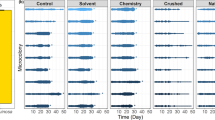Summary
Bumblebees foraging on vertical inflorescences start near the bottom and work upward, behavior commonly interpreted as a response to the greater amounts of nectar available in lower flowers. Lupinus polyphyllus, which produces no nectar, has more pollen available in upper flowers. Although bees are probably unable to detect this gradient, since pollen is hidden from their view, they still start low and forage upward. Therefore, we concluded that the bees' tendency to forage upward on vertical inflorescences is not tied to a reward gradient. In addition, bees use only about 15% of the flowers per inflorescence, although they could be much more efficient by visiting and revisiting every flower systematically. In general, revisits would not be penalized because most flowers contain enough pollen for several visits. Optimal foraging theory may not offer an adequate explanation for such gross inefficiency.
Similar content being viewed by others
References
Benham BR (1969) Insect visitors to Chamaenerion angustifolium and their behaviour in relation to pollination. Entomologist 102:221–228
Best LS, Bierzychudek P (1982) Pollinator foraging on foxglove (Digitalis purpurea): a test of a new model. Evolution 36:70–79
Corbet SA, Cuthill I, Fallows M, Harrison T, Hartley G (1981) Why do nectar-foraging bees and wasps work upward on inflorescences? Oecologia (Berlin) 51:79–83
Cruden RW (1976) Intraspecific variation in pollen-ovule ratios and nectar secretion-preliminary evidence of ecotypic, adaptation. Ann Mo Bot Gard 63:277–289
Dunn DB (1956) The breeding systems of Lupinus. Group Micranthii. Am Midl Nat 55:443–472
Haynes J (1982) Diurnal changes in nectar standing crop of monkshood (Aconitum columbianum) and in foraging behavior of bumblebees (Bombus spp.). Master's thesis, Humboldt State University, Arcata, California
Heinrich, B (1979) Resource heterogeneity and patterns of movement in foraging bumblebees. Oecologia (Berlin) 40:235–245
Hodges CM, Miller RB (1981) Pollinator flight directionality and the assessment of pollen returns. Oecologia (Berlin) 50:376–379
Jander R, Jander U (1970) Über die Phylogenie der geotaxis innerhalb der Bienen (Apoidea). Z vergl Physiologie 66:355–368
Pyke G (1978) Optimal foraging in bumblebees and coevolution with their plants. Oecologia (Berlin) 36:281–293
Pyke G (1979) Optimal foraging in bumblebees: rule of movement between flowers and inflorescences. Anim Behav 27:1167–1181
Schaal B, Leverich W (1980) Pollination and banner markings in Lupinus texensis (Leguminosae). Southwest Nat 25:280–282
Waddington K, Heinrich B (1979) The foraging movements of bumblebees on, vertical “inflorescences”: an experimental analysis. J Comp Physiol 134:113–117
Wainwright C (1978) The floral biology and pollination ecology of two desert lupines. Bull Torrey Bot Club 105:24–38
Zimmerman M (1982a) The effect of nectar production on neighborhood size. Oecologia (Berlin) 52:104–108
Zimmerman M (1982b) Optimal foraging: random movement by pollen collecting bumblebees. Oecologia (Berlin) 53:394–398
Zimmerman M, Pleasants JM (1982) Competition among pollinators: quantification of available resources. Oikos 38:381–383
Author information
Authors and Affiliations
Rights and permissions
About this article
Cite this article
Haynes, J., Mesler, M. Pollen foraging by bumblebees: Foraging patterns and efficiency on Lupinus polyphyllus . Oecologia 61, 249–253 (1984). https://doi.org/10.1007/BF00396768
Received:
Issue Date:
DOI: https://doi.org/10.1007/BF00396768




